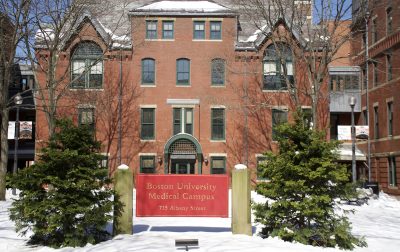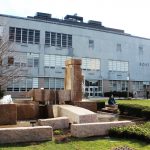
Boston Mayor Martin Walsh put out a call to artists to paint temporary artwork on the exterior of the Finland Building at 774 Albany St., according to a press release published on Wednesday. The call is a continuing effort to revitalize the Melnea Cass Boulevard and Massachusetts Avenue neighborhood near Boston University’s Medical Campus.
The Finland Building offers recovery programs to the city’s addicted or recovering peoples, many of whom are homeless, including treatment plans such as detox and harm reduction services, according to the release.
Ana Karina Vivas, a spokesperson for the Boston Public Health Commission, wrote in an email that BPHC is working with other agencies to beautify the area.
“Through participation in a cross-agency working group, BPHC has helped brainstorm and implement these projects,” Vivas wrote. “We are excited about the opportunity to beautify our building and make it an even more welcoming space.”
Karin Goodfellow, the director of the Boston Art Commission, said the BAC is working alongside the BPHC and the mayor’s office to find additional spots to implement similar art projects meant to facilitate recovery.
“[The mayor’s Office of Arts and Culture] and [the mayor’s Office of Recovery Services] are seeking to commission artwork for the Finland Building that embodies the values of resiliency and hope of those in recovery,” Goodfellow said. “The ORS and the Boston Public Health Commission accept anyone and everyone in need of service into their programs.”
Goodfellow said the project shows the connection between art and recovery.
“It helps the city meet the goals of the Boston Creates Cultural Plan by creating opportunities for artists, bringing more site-specific public art to the public realm and partnering with other sectors to recognize the importance of the arts for wellness,” Goodfellow said.
Vicki Ritterband, a spokesperson for the Boston Health Care for the Homeless Program, which is located across the street from the Finland Building, said in an email the paintings would help the patients on their path to recovery.
“Some of our homeless patients spend many hours of their day in the area, so we endorse this campaign to make the environment more pleasant,” Ritterband said.
The Melnea Cass and Massachusetts Avenue neighborhood is notorious for its high population of homeless people, but is also a beacon of hope for recovering addicts, said Matthew Hoffman, the executive director of the Boston Alcohol and Substance Abuse Program.
Hoffman said art is a powerful medium for conveying messages, and the artwork being done on the Finland Building promotes the idea that Boston supports all its citizens, including those who are homeless or recovering from addiction.
“We are one community,” Hoffman said. “We aren’t two communities in opposition. The homeless and the addicted, they are us.”
Alan Lehmann, director of social enterprises at Project Place, one of the organizations working with the city to refurbish the area, said the cleanup programs have provided a better outlook for locals who struggle with homelessness and substance abuse.
“It makes them feel like people care about them because we are actually taking care of the area that they live in,” Lehmann said.
Lehmann said in the next few weeks, the Melnea Cass and Massachusetts Avenue area will receive 15 flower planters, which will be planted by the Project Place team.
Several Boston residents said they were optimistic about the project and believe it will have positive impacts on the community.
Anne Toupouzis, 54, of Brighton, said the artwork would provide those struggling with homelessness and addiction recovery with feeling of inclusivity.
“I think [the artwork] might give them some idea that the city cares, that they want to make a space for them,” Toupouzis said.
Michael Roycroft, 28, of Brighton, said cleaning up areas where homeless people spend their time could improve their quality of life.
“Homelessness in Boston is a very big issue [and] I feel like it’s neglected,” Roycroft said. “If [their environment] is tidied up, they can tidy themselves up.”
John Skalko, 31, of Brighton, said homelessness in Boston is still a big issue and that the artwork would send a message of hope.
“Anyone of us could easily end up in a position like that, sometimes life just turns for the worst,” Skalko said. “If [the artwork] gives a message of hope and points them in the direction of resources … that would be very good for them.”














